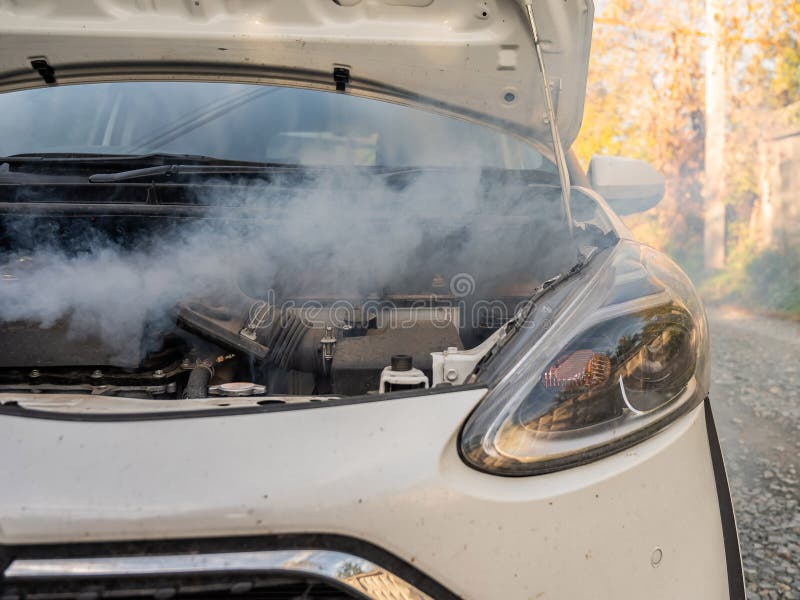Encountering smoke emanating from under your car’s hood can be an alarming experience for any driver. The sight of swirling vapors can undoubtedly spark concern, leading one to ponder the underlying issues at play. Understanding the reasons behind this phenomenon, along with the potential ramifications, can help drivers make informed decisions and ensure their vehicle’s longevity.
When smoke rises from beneath the hood, it can originate from several potential sources. The origin of the smoke is paramount in determining the necessary course of action. There are three primary types of smoke that drivers may observe: white smoke, blue smoke, and black smoke. Each color signifies different issues, and discerning between them is crucial for accurate diagnostics.
White Smoke: White smoke typically indicates a more serious concern. This could be a sign of coolant leaking into the engine. The coolant may seep through cracks in the engine block or head gasket, resulting in steam that resembles smoke. Overheating can exacerbate the situation, creating a perfect storm where the engine is overworked and coolant is compromised. An engine suffering from a blown head gasket can lead to catastrophic damage if neglected, thus it’s imperative to shut off the engine and consult a mechanic immediately.
The appearance of white smoke could also point to another culprit: condensation. Upon starting your vehicle, particularly in cooler climates, it’s not uncommon to see a small plume of white vapor. This is typically harmless and should diminish as the engine warms up. However, if this phenomenon persists beyond the initial start-up, further investigation is warranted.
Blue Smoke: Blue smoke is often indicative of burning oil. This occurs when oil is leaking into the combustion chamber, which can result from worn piston rings, valve seals, or other engine components. Not only does this compromise engine performance, but it can also lead to increased oil consumption and potential engine failure if left unabated. Drivers should monitor their oil levels and look for any indications of oil leakage beneath the vehicle. Regular maintenance, including timely oil changes, can help mitigate this risk.
Additionally, blue smoke may manifest during acceleration, pointing towards a more acute issue with the engine’s internal components. Should this be your experience, it’s wise to consult with a professional mechanic for a thorough diagnosis and remedy.
Black Smoke: Unlike the previous types of smoke, black smoke is usually associated with fuel-related issues. An excessively rich fuel mixture can produce black smoke, suggesting that too much fuel is being injected into the combustion chamber. This may be attributed to faulty fuel injectors, a malfunctioning mass airflow sensor, or a defective engine control unit (ECU). It’s not only detrimental to engine performance but also poses a risk to the environment due to heightened emissions.
Moreover, the presence of black smoke may also indicate incomplete combustion. This can lead to fouling of spark plugs and necessitate replacement. Addressing this early on can save the driver from a potential cascade of repairs down the line.
Other Causes of Under Hood Smoke: Apart from the common types of smoke discussed, various other causes can lead to visible smoke. For instance, a leaking or damaged radiator hose can produce steam that appears smoky. Likewise, when engine oil is spilled onto hot engine components, it can ignite and create smoke. Engaging in routine maintenance, such as checking hose integrity and ensuring that engine fluids are at appropriate levels, is fundamental for preventing such mishaps.
It’s also important to highlight that the condition of your vehicle’s belts and wiring can affect smoke production. Frayed belts may rub against other components, generating friction and creating smoke. Similarly, electrical issues—such as short-circuits—can heat wires to the point of causing them to smolder and emit smoke. Observing unusual smells, such as burnt rubber or electrical burning, can also signal an issue that requires immediate attention.
What to Do When You See Smoke: If you notice smoke escaping from under your vehicle’s hood, your immediate priority should be safety. If driving, carefully pull over to a safe location and turn off the engine. Allow the engine to cool before opening the hood, as the rapid temperature change could cause burns or other injuries. Examining the situation while maintaining a safe distance is prudent, as unknown factors in smoke production can pose risks.
After ensuring the area is secure, a visual inspection can be conducted. Look for visible signs of leaks or burnt components. However, if the source of the smoke seems hidden or complex, it is advisable to consult a professional mechanic. Timely, professional intervention can save you from extensive repairs and ensure the surrounding environment remains safe and healthy.
Prevention Strategies: To minimize the likelihood of under hood smoke, regular vehicle maintenance plays a vital role. Adhering to a scheduled maintenance program, including oil changes, coolant checks, and inspecting engine components for wear or damage, can drastically reduce the risk of these issues arising. Additionally, drivers should familiarize themselves with their particular vehicle’s specifications, ensuring they understand what maintenance is required and when.
In conclusion, while the sight of smoke from under your hood can be unnerving, understanding the various causes can empower drivers to take appropriate action. Whether it’s addressing a minor issue or halting serious damage, staying informed and proactive can ensure your vehicle remains in optimal condition for years to come. Regular checks and professional consultations when necessary can mean the difference between a routine repair and a catastrophic engine failure.
